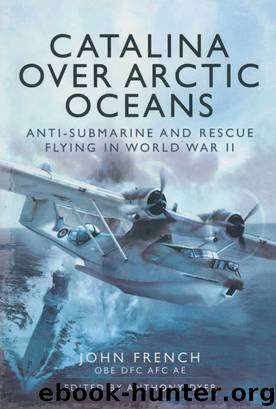Catalina over Arctic Oceans: Anti-Submarine and Rescue Flying in World War II by John French

Author:John French [French, John]
Language: eng
Format: azw3, epub
ISBN: 9781473803350
Publisher: Pen and Sword
Published: 2013-02-04T16:00:00+00:00
CHAPTER TEN
Operations in 1944
As February 1944 came towards its end, the crew and I were detailed to escort Russian convoy JW 57, to be met far away, north of the Arctic Circle. We were to take-off fairly late that day. In the afternoon, while walking along the shore of the Voe I saw twenty-five migrating herons (my ‘lucky’ bird) on the shore not far from the camp. The flight was to be long, there was little daylight up north at that time of the year and the weather picture showed that we would be flying against strong northerly winds, with front after front and snow storms and icing. The air would be bumpy and altogether it was not one of the most promising situations. We were loaded with full overload tanks and only a pair of depth charges. Our scheduled time with the convoy was to be rather less than two hours, as I remember. We used the radar sparingly as we neared the convoy, but had been told that one of the ships was carrying a radar responder beacon on to which we might home. Suddenly, when not far off our ETA (estimated time of arrival), we got a return on the radar. We let down out of the cloud to see beneath us a rough sea, an angry, ugly sea, with snow flurries all around and then, some miles off, the wake of a ship. I suddenly realized that this was not a surface ship of the convoy escort, but a submarine. As we dived and accelerated towards the vessel, Jacko made a quick check that there were no Royal Naval submarines in the area. As we came closer the U-boat opened fire with 37mm and machine gun fire, the tracers coming lazily and then faster towards us and the shells exploding. The fire was erratic because of the heavy sea and the U-boat Captain unwisely decided to remain on the surface. Our own nose gunner fired a few shots with the .30 gun, but that soon packed up with a stoppage. We got down to attack level and approached up the line of the stern, the firing had, I think stopped. I pressed the release button and away went our two depth charges; we were at a pretty low height. We turned to see the result. Bill McGuinty had opened the blister and had been hard at work with the K.20 camera. It was said that he was halfway out of the blister with Jock Brown holding on to his feet. His pictures were perfect and within a few days it was confirmed that the U-boat (later to be identified as U-601) had been definitely sunk. Visually, as we turned, we saw the bows rise as the U-boat came out from between the subsiding plumes of the explosions and by the time we got round and passed over the scene, only a few men, some odd bits of wreckage and patches of oil were in the water. One man shook his fist at us.
Download
Catalina over Arctic Oceans: Anti-Submarine and Rescue Flying in World War II by John French.epub
This site does not store any files on its server. We only index and link to content provided by other sites. Please contact the content providers to delete copyright contents if any and email us, we'll remove relevant links or contents immediately.
| Afghan & Iraq Wars | American Civil War |
| American Revolution | Vietnam War |
| World War I | World War II |
Waking Up in Heaven: A True Story of Brokenness, Heaven, and Life Again by McVea Crystal & Tresniowski Alex(36998)
Empire of the Sikhs by Patwant Singh(22163)
We're Going to Need More Wine by Gabrielle Union(18064)
Hans Sturm: A Soldier's Odyssey on the Eastern Front by Gordon Williamson(16565)
Leonardo da Vinci by Walter Isaacson(11894)
The Radium Girls by Kate Moore(10901)
Educated by Tara Westover(7055)
Tools of Titans by Timothy Ferriss(6934)
How to Be a Bawse: A Guide to Conquering Life by Lilly Singh(6686)
The Last Black Unicorn by Tiffany Haddish(5065)
Permanent Record by Edward Snowden(4986)
The Rise and Fall of Senator Joe McCarthy by James Cross Giblin(4839)
Promise Me, Dad by Joe Biden(4440)
The Wind in My Hair by Masih Alinejad(4420)
The Crown by Robert Lacey(4098)
A Higher Loyalty: Truth, Lies, and Leadership by James Comey(4024)
The Iron Duke by The Iron Duke(3635)
Joan of Arc by Mary Gordon(3253)
How to be Champion: My Autobiography by Sarah Millican(3180)
